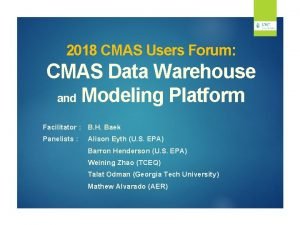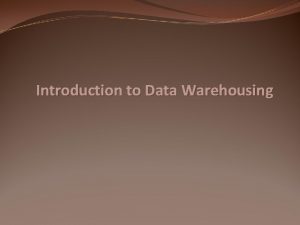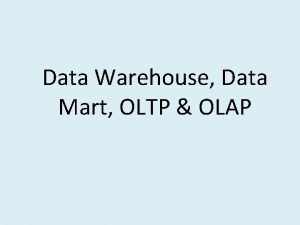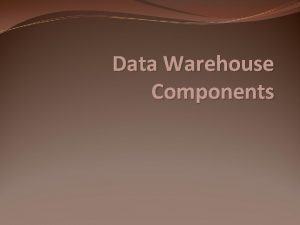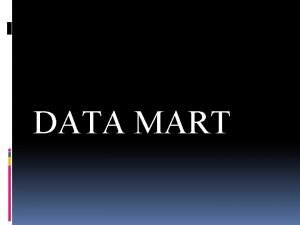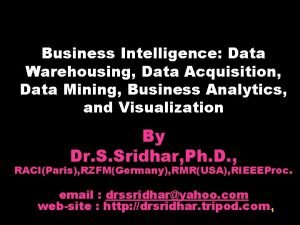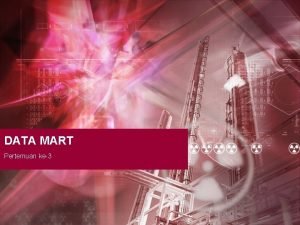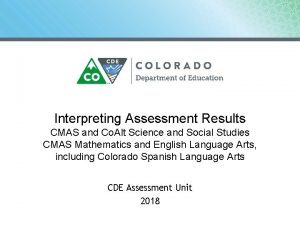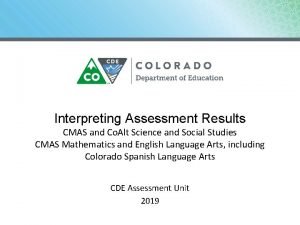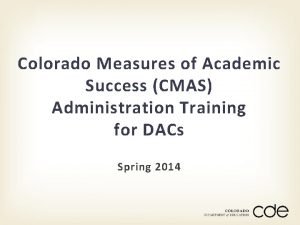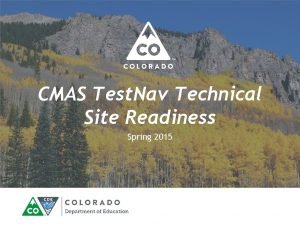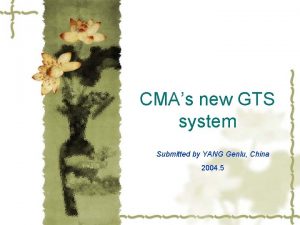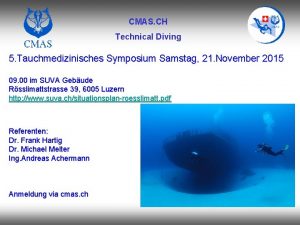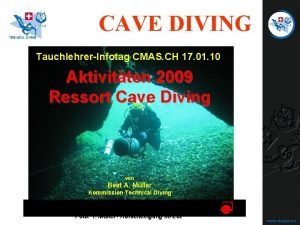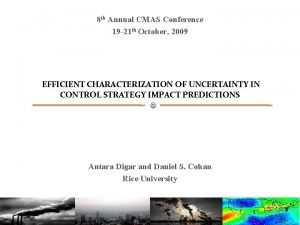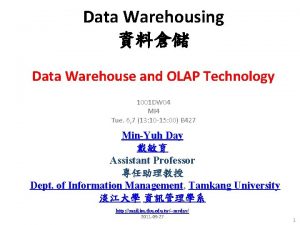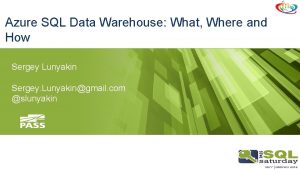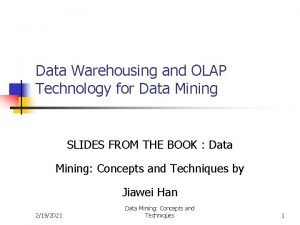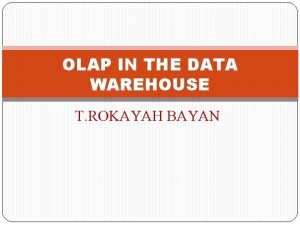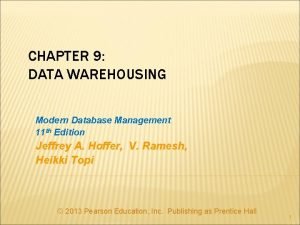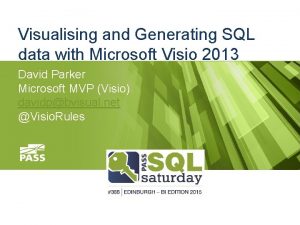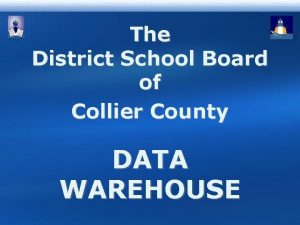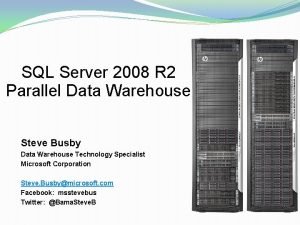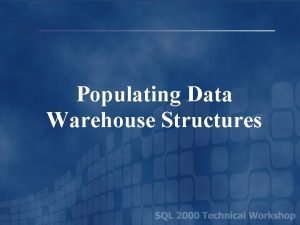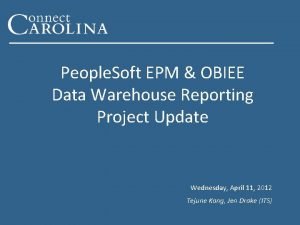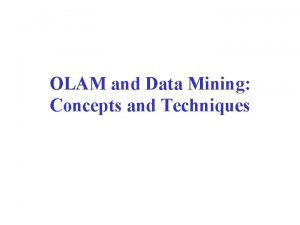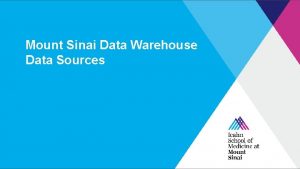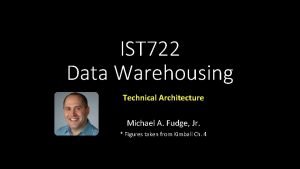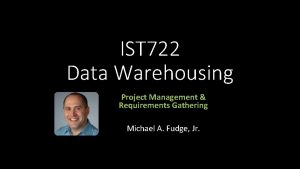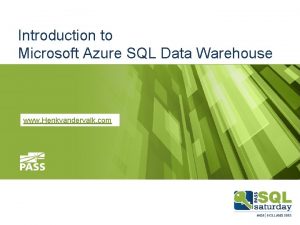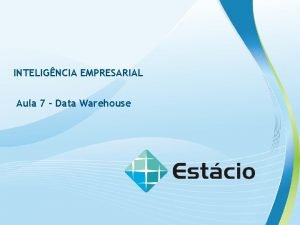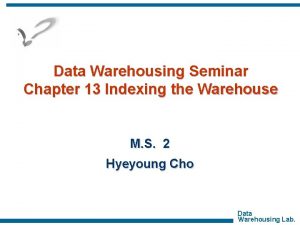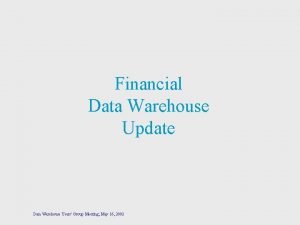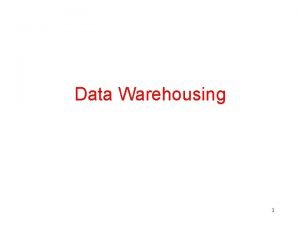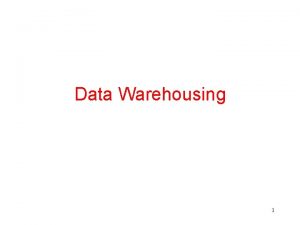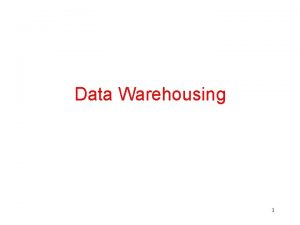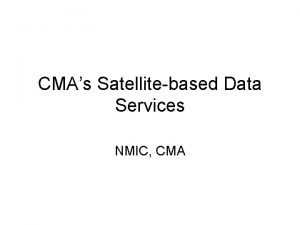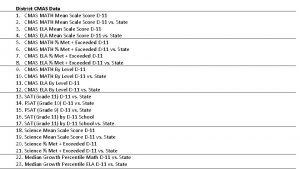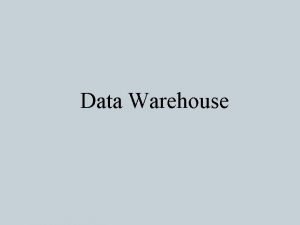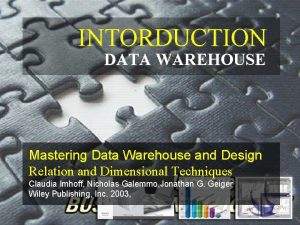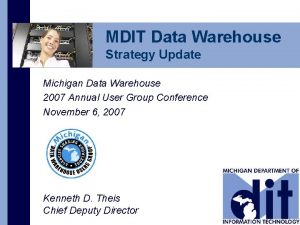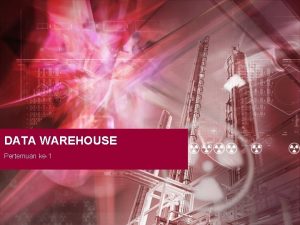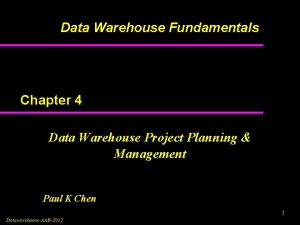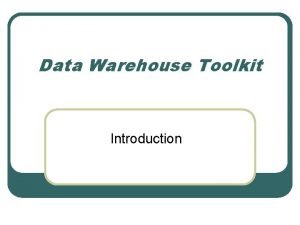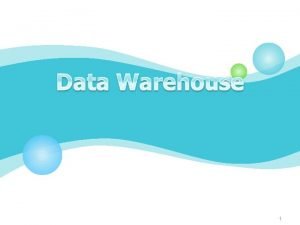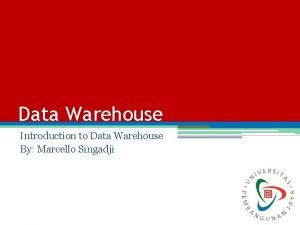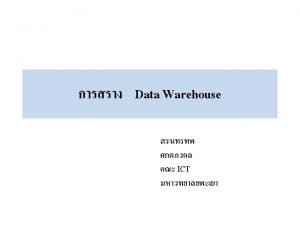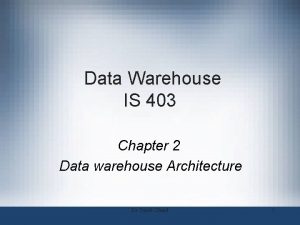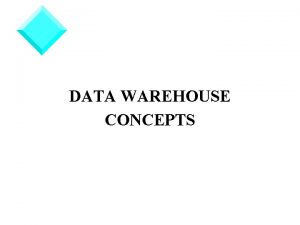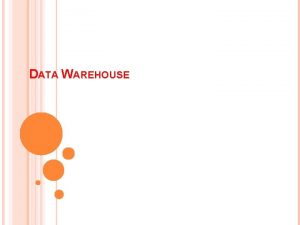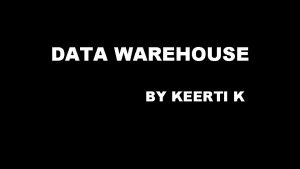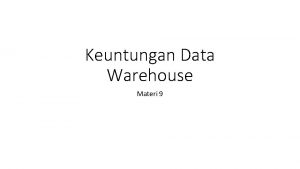2018 CMAS Users Forum CMAS Data Warehouse and











































- Slides: 43

2018 CMAS Users Forum: CMAS Data Warehouse and Modeling Platform Facilitator : B. H. Baek Panelists : Alison Eyth (U. S. EPA) Barron Henderson (U. S. EPA) Weining Zhao (TCEQ) Talat Odman (Georgia Tech University) Mathew Alvarado (AER)

Motivations q q The m 3 users community would benefit from access to new, open datasets • Modeling Inputs and outputs • Share their own models, datasets and tools Better/Easier Discoverability • With more download options q Citations for models, datasets, and tools q How can we make modeling setup and runs easy, affordable, and portable? • Easier Installation and setup of modeling systems • Low cost option for air quality modeling system • Global Support 17 th Annual CMAS Conference October 24, 2018

Panelist Presentations 1. Barron Henderson: AQ Modeling Group, OAQPS, U. S. EPA 2. Alison Eyth: Inventory and Analysis Group, OAPQS, U. S. EPA 3. Weining Zhao: Texas Commission on Environmental Quality (TCEQ) 4. Matthew Alvarado: Atmospheric and Environment Research (AER) 5. Talat Odman: Professor, Georgia Tech University 17 th Annual CMAS Conference October 24, 2018

CMAS Cloud Data Warehouse Product CMAQ • 12 US 1 (2002 -2014) Storage (GB) 876 68 per year SMOKE • 2014 fd_2015 fd_2016 fd • NEIshare • • MCIP Onroad (MOVES) Surrogates • soas_2013_cb 6 • WRFv 3. 8_12 US_2015 • WRFv 3. 8_4 NE 2_2015 300 506 83 25 875 4, 354 565 IC/BC • 2014_12 US 1 • cb 6 r 3_ae 6_aq Total 17 th Annual CMAS Conference 0. 660 359 8, 588 October 24, 2018

CMAS Data Warehouse: Dataverse 17 th Annual CMAS Conference October 24, 2018

Dataverse Features: q Metadata Support q Versioning Capability q Discoverability and Searchability q Published Data and Models Citation § q DOI : Digital Object Identifier Data File types § Data Provenance § Any types of datasets: NCF, JPG, Rdata, Various Tabular formats, Geospatial, Compressed Files, , , § Cloud Storage + Computing 17 th Annual CMAS Conference October 24, 2018

CMAS Cloud Modeling Platform q Cloud Computing Platforms: § q Cloud Ecosystem: § q Google Cloud Platform and Amazon Web Services Direct Access to the Cloud Data Storage Cloud-based Modeling System Instances § Individual or multiple modeling system Instances § CMAQ, SMOKE, WRF, EMF, AMET, Spatial Allocator, Speciation Tool Instances including input datasets, and run scripts 17 th Annual CMAS Conference October 24, 2018

Benefits of CMAS Cloud Modeling Platform § Easy to Scale Up (More Computing Power and Storage) § Facilitate Collaborations (Sharing identical Instances) § No Hardware and System Maintenance and Updates § No full-time IT Support Staff (No Overhead) § On-Demand Usages: (Low Modeling Costs) § Data Safety and Automatic Backups § World-Wide Zone Support for the fastest connectivity to the Cloud Platforms 17 th Annual CMAS Conference October 24, 2018

Use Case: MARAMA EMF-SMOKE-MOVES in AWS 17 th Annual CMAS Conference October 24, 2018

Use Case: Cost Estimates using AWS v On-Demand instance v Shut down during the night and the weekend v Cost Estimates: [Total : Average $300/month] v § EMF on AWS Instance m 3. xlarge ($0. 266/hr) : 226 hours ≃ $71/month § 2 TB shared EBS HDDs: 0. 10 per GB-Month ≃ $200 per month SMOKE Modeling Runs on m 3. xlarge instance ($0. 266/hr) § v One month of regional SMOKE run: 22 hours run times = $6 /month MOVES modeling runs on m 4. xlarge instance ($0. 252 per hour) § One reference county MOVES 2014 a : 80 hours ≃ Approx. $20 per county § 304 reference counties * $20 ≃ over $6, 000 for CONUS modeling domain 17 th Annual CMAS Conference October 24, 2018

Poll. Ev. com/cmas 1. What is your organization sector? 2. What is the Biggest Challenges in your current workflow? 3. What Models/Tools do you use in your current workflow? 4. What pre-built images on Cloud Computing would you want to use? 17 th Annual CMAS Conference October 24, 2018

Data Sharing from a Few Perspectives Barron H. Henderson Private consultant (2002 -2006, and here and there) Academic at the UNC and UF (2006 -2016) Government Scientist at EPA (2016 -present)

Competing Generator and User interests • Generating data takes your time and is risky • If the process is simple and quick, will the research community accept the methods? • Will the regulatory community accept the results? • Data Users benefit by collecting data • Storing data is cheap (for many organizations) • Time lost hurts: profit, publications, other? • So the tendency is to request data from providers/generators… • even if you might not need it • Zac Adelman told me he called folks that do this “data collectors” • Perhaps there is a role for “data collectors”…

Ideal world • Data generators want to share • Data collectors act as intermediate repositories • Data users only get what they need from data collectors • This is really the Amazon Web Services model (and others) • Data generators may generate on AWS and store data • Agreements can be reached to host data “long-term”, where AWS acts as the data collector • Data users can independently connect to the data store.

My AWS Experience • CPU time on AWS is reasonably cheap • Data storage on AWS is reasonably cheap • Data download is expensive • Incentive: generate where ever, store in cloud, download only what is necessary and/or use in the cloud • Dr. Alvarado has good news on these fronts • Reality check • Most users do not need to look at every 4 -D DENS variable in MCIP • Most users do not need to look at every 4 -D XO 2 variable in CONC • Most don’t want WRF… etc

Cloud Computing Limitations • By itself, cloud computing does not solve our organization problems. • Cataloguing and discovery is a separate equally important issue. • Can we partner with library sciences? • Geographic Information Systems already has made a lot of progress.

Appendix My initial thoughts on questions we will be asked.

1. What kind of data can be shared? • Anything can be shared on cloud computing, because whole disks can be almost instantly shared

2. What are the most common constraints with sharing data? • Data ownership and credits • Proprietary value • Fear of unconstructive criticism

3. How the data can be shared? Data discoverability and Data citation (DOI) • Not sure I get this one • availability of documentation that describes the data, how the data were generated, and any limitations/caveats about the data; • ability of data users to interact with the data generators to ask questions about the data; and • responsibility, if any, of the data generator to notify the data users when errors are discovered in the data and/or when updates are made.

4. How can we leverage cloud computing to facilitate Emissions, Air Quality Modeling and Data Analysis? • Great question! • Analysis systems are notoriously hard to install. • Clonable nodes with analysis systems seems like a great place to start. • Clonable data stores means easy application of analysis systems to other data stores. • Instead of getting data providers to put data in special formats and upload to special systems, analysis systems need to be more nimble • Meta-data conventions are important • Analysis system conventions is key too.

5. What is your experience with the cost (financial and personnel) of using cloud computing versus purchasing in-house hardware? • Benefits of in-house is of budget applications • Buy once • Use til it dies • Increasingly against the “rules” • Benefits of cloud computing • • Management costs included in price Package management mostly included in price Backup availability included in price Amazon likely has lower overhead per node than smaller providers

6. What benefits or advances do you foresee from data sharing and cloud computing? • Connecting systems to data and data to systems (see question 4) • Are you willing to throw more resources at a problem? Now you could.

Data Sharing and Cloud Computing for Emissions and Air Quality Modeling Alison Eyth U. S. EPA Office of Air Quality Planning & Standards Emission Inventory and Analysis Group October 24, 2018

Data Sharing Requests EPA receives dozens of requests for emissions and air quality model input and output data each year ◦ Requestors are from state/local governments, academia, consultants, non-profits, regional organizations, etc. Requests are for SMOKE, WRF, CMAQ, and CAMx input and output files for regulatory and non-regulatory cases ◦ Most SMOKE input files are small enough to make available on EPA’s web/FTP site, but reassembly for use can be tricky �https: //www. epa. gov/air-emissions-modeling ◦ Many other files are too large for the FTP area and are transferred via physical hard drives �For popular data, sometimes we transfer drives to regional organizations who send the drive around to the others Servicing of data requests requires significant staff time 25

Future Directions in Data Sharing Today’s network speeds make it easier to transfer larger data sets Would like to get away from shipping drives around Ideal solutions allow us to post data once, where everyone who needs the data can retrieve them ◦ OAQPS is working with UNC to post full distributions of emissions modeling inputs and selected outputs �https: //drive. google. com/drive/folders/1 ca. RJVHx_Sz. Y 0 s. SD 6 DLTE 7 rg. Ao. SDqrt�Helps reduce issues with reassembly compared to the split up versions on our FTP site �Also posting some sector-specific SMOKE outputs �More work on this is needed (2016 platform beta and v 1. 0) 26

Use of Cloud Computing Cloud computing is useful for easily decomposed problems ◦ Use MOVES to compute winter and summer onroad emission factors (EFs) for each of 300 representative counties ◦ Use independent nodes / instances to run each of the 600 county-months and download EFs after runs complete Cloud computing could make emissions and AQ modeling accessible to more organizations ◦ ◦ Provide working compiled versions of models (yay!) Make available key input data sets with working scripts Streamline applications to new grids / scenarios Reduces need for hardware and system administration 27

EPA’s 2019 International Emission Inventory Conference Biennial conference that connects offices across EPA, regional/state/local/tribal staff, researchers, consultants, and students who work on various aspects of emissions inventory development 2019 Theme: “Collaborative Partnerships to Advance Science and Policy” July 29 -August 2, 2019 in Dallas, Texas ◦ Training on Monday, July 29 ◦ Tuesday-Friday: plenary session, technical sessions, lightning talks ◦ More info coming soon to: https: //www. epa. gov/ air-emissions-inventories/international-emissioninventory-conference 28

Air Quality Modeling Data on TCEQ Website https: //www. tceq. texas. gov/airquality/airmod/data Weining Zhao, Texas Commission on Environmental Quality, October 24, 2018

Texas Ozone SIP Modeling Data (2012 Episodes) Weining Zhao, Texas Commission on Environmental Quality, October 24, 2018

TCEQ Modeling Data FTP Site 2. 5 TB raw EI data CAMx input and output data no WRF data Weining Zhao, Texas Commission on Environmental Quality, October 24, 2018

Interactive Time-Series Evaluation Tool Weining Zhao, Texas Commission on Environmental Quality, October 24, 2018

Ozone Design Value Visualization Tool Ozone Transport SIP Modeling Weining Zhao, Texas Commission on Environmental Quality, October 24, 2018

Cloud Computing: An Academic Perspective Talat Odman and Kevin Kelly 17 th Annual CMAS Conference Chapel Hill, North Carolina October 24, 2018


Challenge - Moving the Data ● Too much data! ● Copying TBs over the Internet ○ ○ ○ Variable speeds Sometimes lacks reliability Wait hours to find out results 36

Cloud HPC On-Demand Capacity P u b l i c C l o u d H P C C o m p u Dt aa tt ai o Sn t o. E E n d U s

Cloud Computing vs On-Premise ● Optimize costs for spiky compute patterns ● ● On-demand for unexpected compute needs Increase capacity without commitments ● Control user access and billing ● Provide users a familiar HPC platform ● Manage hybrid compute by splitting workloads between on-premise and cloud 38

AQcast System for CMAQ on Amazon Cloud (Also have CAMx and WRF-Chem variants) • Features – Automatically performs all pre-processing steps, including weather modeling – Flexible and simple interface • Benefits – High number of simultaneous runs (ensembles, sensitivity studies) – Reduces labor cost of modeling studies 39

NASA Applied Science Project: Use AQcast to improve monthly-mean NH 3 emissions 40

“Let me explain. No, there is too much. Let me sum up. ” Inigo Montoya, The Princess Bride • Sharing data is a great idea! – Cuts down on unnecessary duplication – Facilitates review, reproducibility, and sensitivity studies • A CMAS Data Warehouse is a great idea! – Providing access to complete input/output data from past projects would be a great benefit to the community • Releasing CMAQ and other models as virtual machines or containers is a great idea! – All libraries already included – No more compiler/OS errors wasting user’s time 41

“Let me explain. No, there is too much. Let me sum up. ” Inigo Montoya, The Princess Bride • Cloud computing has effectively no limits, so you need to set your own. Controlling costs requires planning ahead. • Sharing data is great, but moving data is expensive – Data and computation should stay in the same cloud – Need methods to review runs without downloading data • CMAS Data Warehouse should include complete projects – Multiple project types with links to ALL of the input data, model containers/VMs, run scripts, and output – Different run types (e. g, HDDM, Adjoint) in separate containers? • Need to consider Warehouse cost and permission issues – Is everyone going to have read/write/execute permission? – Who pays for storage? Downloads? – Negotiating discounts will likely require picking a cloud provider 42

Questions? Email Matt Alvarado (malvarad@aer. com) 43
 Cmas forum
Cmas forum Olap data warehouse
Olap data warehouse Operational and informational data store in data warehouse
Operational and informational data store in data warehouse What is kdd process in data mining
What is kdd process in data mining Contoh data mart
Contoh data mart Data warehouse elements
Data warehouse elements Data mart
Data mart Perbedaan data warehouse dan data mining
Perbedaan data warehouse dan data mining Data mining dan data warehouse
Data mining dan data warehouse What is data acquisition in data warehouse
What is data acquisition in data warehouse Data warehouse vs data mart
Data warehouse vs data mart Multitier architecture of data warehouse
Multitier architecture of data warehouse Data warehouse dan data mining
Data warehouse dan data mining Datamart olap
Datamart olap Dada la siguiente secuencia rusia 2018 rusia 2018
Dada la siguiente secuencia rusia 2018 rusia 2018 Cio forum 2018
Cio forum 2018 Pgcs score
Pgcs score Cmas score interpretation
Cmas score interpretation Colorado test nav
Colorado test nav Cmas test nav
Cmas test nav Mfc cmas
Mfc cmas What is com.lge.cmas
What is com.lge.cmas Anatmia
Anatmia Cmas.ch
Cmas.ch Cmas.ch
Cmas.ch Cmas conference
Cmas conference Data warehouse and olap technology
Data warehouse and olap technology Azure sql data warehouse smp
Azure sql data warehouse smp Data warehouse and olap technology
Data warehouse and olap technology Olap stand for
Olap stand for Modern data base and warehouse
Modern data base and warehouse Visio sql
Visio sql Collier county schools data warehouse
Collier county schools data warehouse Microsoft sql server 2012 parallel data warehouse
Microsoft sql server 2012 parallel data warehouse Populating data warehouse
Populating data warehouse Epm data warehouse
Epm data warehouse Olam in data mining
Olam in data mining Mount sinai data warehouse
Mount sinai data warehouse Front room vs backroom data warehousing
Front room vs backroom data warehousing Data warehouse requirements gathering
Data warehouse requirements gathering Sys.dm_pdw_exec_requests
Sys.dm_pdw_exec_requests Azure sql data warehouse mpp
Azure sql data warehouse mpp Data warehouse empresarial
Data warehouse empresarial Data warehouse seminar
Data warehouse seminar
